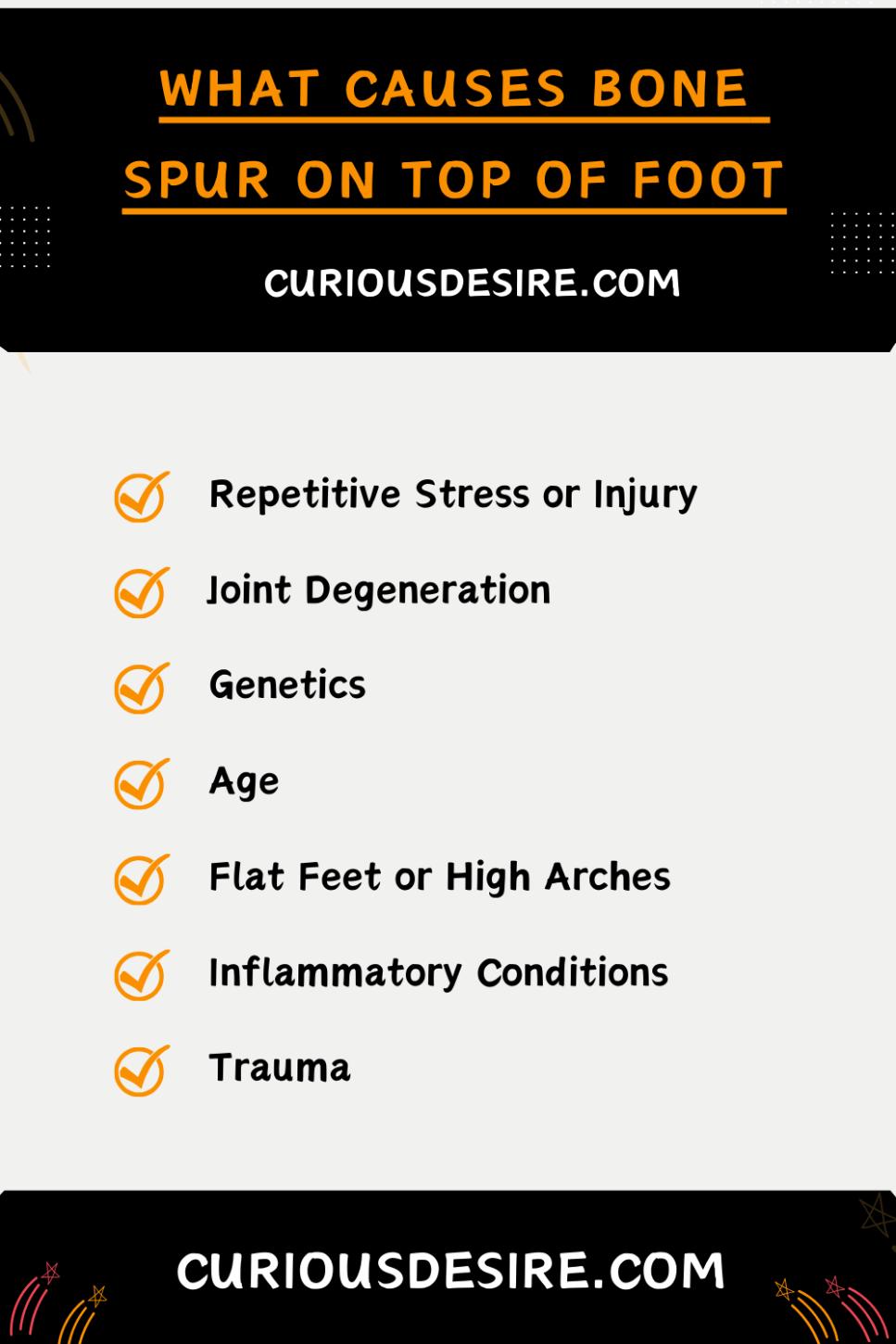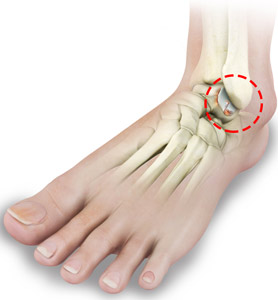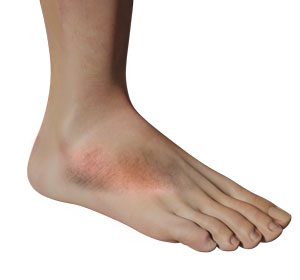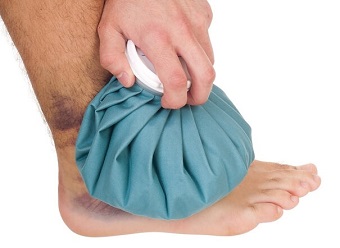Bone spurs, also known as osteophytes, are bony outgrowths that can develop on the surface of bones in various parts of the body, including the feet.
When bone spurs form on the top of the foot, they can cause pain, inflammation, and mobility issues, impacting one’s ability to walk and engage in daily activities comfortably.
Understanding the underlying causes of bone spurs on the top of the foot is crucial for effective management and treatment.
Here are the top 3 causes of a bone spur on top of the foot:
- Joint Degeneration
- Inflammatory Conditions
- Repetitive Stress or Injury
[toc]

1. Repetitive Stress or Injury
Overuse or repetitive stress on the foot can occur in various scenarios that contribute to the development of bone spurs.
For athletes, particularly runners and basketball players, the constant impact and pressure on the feet during activities can lead to microtrauma in the bones and soft tissues.
Similarly, individuals who spend long hours on their feet for work, such as nurses or retail workers, may experience repetitive stress.
Additionally, wearing shoes that don’t provide adequate support or cushioning, or that are too tight, can exacerbate stress on the feet, increasing the likelihood of bone spur formation.
2. Joint Degeneration
Osteoarthritis, the most common form of arthritis, gradually wears away the cartilage that cushions the ends of bones in the joints.
As the cartilage breaks down, the bones may rub against each other, causing pain, swelling, and stiffness.
In response to this joint damage, the body may form bone spurs in an attempt to stabilize the joint and reduce friction.
These spurs can develop not only in weight-bearing joints like the knees and hips but also in the smaller joints of the foot, such as those in the toes or midfoot.
3. Genetics
While the exact genetic factors contributing to bone spur formation are not fully understood, evidence suggests that certain genes may influence an individual’s susceptibility to developing bone spurs.
Research has identified specific gene variants associated with conditions like osteoarthritis, which predispose individuals to joint degeneration and subsequent bone spur formation.
Additionally, inherited traits related to foot structure or biomechanics may increase the risk of developing bone spurs in certain individuals.
4. Age
Aging is a natural process that affects the entire body, including the bones and joints.
As people get older, their bones may become less dense and more susceptible to degenerative changes.
Cartilage also tends to wear down over time, leading to conditions like osteoarthritis.
These age-related changes can increase the likelihood of developing bone spurs, particularly in weight-bearing joints like the feet.
Additionally, older adults may have accumulated years of wear and tear on their feet, further predisposing them to bone spur formation.
5. Flat Feet or High Arches
Foot structure plays a significant role in how weight is distributed across the foot during standing, walking, and other activities.
Flat feet (pes planus) occur when the arch of the foot collapses, causing the entire sole to come into contact with the ground.
This can lead to excessive pronation (inward rolling) of the foot, which can increase stress in certain areas and contribute to the development of bone spurs.
Conversely, high arches (pes cavus) can cause the foot to under pronate (insufficient inward rolling), leading to different areas of the foot bearing excessive pressure and potentially resulting in bone spur formation in those areas.
6. Inflammatory Conditions
Inflammation plays a key role in many foot conditions, including tendonitis and plantar fasciitis.
Tendonitis involves inflammation and irritation of the tendons, which connect muscles to bones and help stabilize joints.
Plantar fasciitis is inflammation of the plantar fascia, a thick band of tissue that runs along the bottom of the foot.
Chronic inflammation in these tissues can stimulate the body’s natural response to repair and stabilize the affected area, leading to the formation of bone spurs at the insertion points of tendons or ligaments on the bones of the foot.
7. Trauma
Acute or chronic trauma to the foot, such as fractures, sprains, or repetitive injuries, can disrupt the normal structure and function of the bones and soft tissues.
In response to this trauma, the body may initiate a healing response that involves the deposition of new bone tissue.
Over time, this process can lead to the formation of bone spurs at the site of injury as the body attempts to stabilize and support the damaged area.
Additionally, improper healing of fractures or inadequate rehabilitation following injury can increase the risk of developing bone spurs in the affected foot.
Treatment for Bone Spur on Top of Foot
Treatment for bone spurs on the top of the foot typically focuses on relieving symptoms, reducing inflammation, and addressing the underlying factors contributing to their formation.
Here are some common treatment approaches:
1. Rest and Modification of Activities
Resting the foot and avoiding activities that exacerbate pain or irritation can help reduce inflammation and allow the affected area to heal.
Modifying activities to reduce impact and stress on the foot, such as switching to low-impact exercises or wearing supportive footwear, can also be beneficial.
2. Ice Therapy
Applying ice packs to the affected area for 15-20 minutes several times a day can help reduce pain and inflammation associated with bone spurs.
It’s essential to wrap the ice pack in a cloth to prevent direct contact with the skin and avoid icing for too long to prevent frostbite.
3. Pain Management
Over-the-counter nonsteroidal anti-inflammatory drugs (NSAIDs), such as ibuprofen or naproxen, can help alleviate pain and reduce inflammation associated with bone spurs.
However, it’s essential to use these medications according to the recommended dosage and duration to avoid potential side effects.
4. Orthotic Devices
Custom orthotic inserts or arch supports can help redistribute pressure and support the foot’s natural alignment, reducing stress on the affected area and providing relief from symptoms.
Over-the-counter shoe inserts may also be beneficial for some individuals.
5. Footwear Modification
Wearing supportive and properly fitting footwear with cushioning and adequate arch support can help alleviate symptoms and prevent further irritation of the bone spur.
Avoiding high heels and shoes with narrow-toe boxes can also help reduce pressure on the foot.
6. Corticosteroid Injections
In cases where conservative treatments fail to provide sufficient relief, corticosteroid injections may be recommended to reduce inflammation and alleviate pain associated with bone spurs.
These injections are administered directly into the affected area under ultrasound guidance.
7. Extracorporeal Shock Wave Therapy (ESWT)
ESWT is a non-invasive treatment option that uses high-energy shock waves to stimulate healing and reduce pain associated with bone spurs.
This therapy is typically performed on an outpatient basis and may require multiple sessions for optimal results.
8. Surgical Intervention
In severe cases where conservative treatments are ineffective, or if the bone spur is causing significant pain or interfering with mobility, surgical removal may be considered.
This procedure, known as osteotomy or osteophytectomy, involves removing the bony outgrowth and any associated soft tissue irritation.
Bone Spur On Top Of Foot Causes FAQs
1. How to fix a bone spur on top of your foot?
Treatment options include rest, ice therapy, pain management, orthotic devices, physical therapy, and surgical removal if necessary.
2. Do foot bone spurs go away?
No, they typically do not resolve on their own but symptoms can be managed with treatment.
3. What causes a bony lump on top of the foot?
Various factors including repetitive stress, joint degeneration, genetics, age-related changes, foot structure abnormalities, inflammatory conditions, trauma, and metabolic disorders can cause bony lumps.
4. What is the fastest way to heal a bone spur?
A combination of rest, ice therapy, pain management, and medical interventions under the guidance of a healthcare professional.
5. What vitamin is good for bone spurs?
Vitamin D, calcium, vitamin K2, and magnesium may support bone health but consult a healthcare provider before starting supplements.
6. Is walking bad for bone spurs?
Moderate, low-impact walking may be beneficial but listen to your body and modify activities to avoid aggravating symptoms.
7. What naturally dissolves bone spurs?
There’s limited evidence for natural remedies but conservative treatments like rest, ice therapy, physical therapy, and appropriate footwear may help manage symptoms.
8. What foods prevent bone spurs?
A balanced diet rich in calcium, vitamin D, vitamin K, magnesium, and phosphorus may support overall bone health.
9. Exercise for bone spurs?
Exercise to improve flexibility, strength, and range of motion in the foot and ankle can help alleviate symptoms.
10. Can you massage a bone spur?
Gentle massage techniques on surrounding muscles and soft tissues may provide relief, but avoid direct pressure on the bone spur.
11. Home remedies for bone spurs?
Rest, ice therapy, over-the-counter pain medications, orthotic devices, appropriate footwear, and gentle stretching exercises may help manage symptoms.
12. Do bone spurs keep growing?
They may continue to grow slowly over time if underlying factors are not addressed, but symptoms can be managed with treatment and further growth may be prevented or slowed down.
Regular monitoring by a healthcare professional is important.


